Saving your town from the bike ninjas: a how-to
Dressed all in black, biking down your street the wrong way in the middle of the 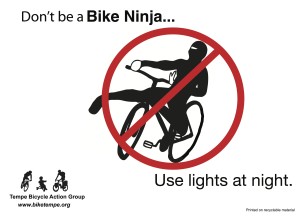 night, giving no sign of their existence save for the squeak of a rusty chain: the bike ninja is a fearsome adversary indeed. They’re rarely seen until they’re right in front of you, requiring a sudden swerve out of the way and perhaps a fist shaken in their general direction. Riding a bicycle at night without adequate lighting is unsafe and against the law in most states, but many cyclists do it anyways, either because they’re not aware of the dangers or they don’t want to deal with the inconvenience of buying and maintaining bike lights.
night, giving no sign of their existence save for the squeak of a rusty chain: the bike ninja is a fearsome adversary indeed. They’re rarely seen until they’re right in front of you, requiring a sudden swerve out of the way and perhaps a fist shaken in their general direction. Riding a bicycle at night without adequate lighting is unsafe and against the law in most states, but many cyclists do it anyways, either because they’re not aware of the dangers or they don’t want to deal with the inconvenience of buying and maintaining bike lights.
Here at the Tempe Bicycle Action Group, one of our recurring events it the Bike Lights for Ninjas ride: volunteers stake out a handful of streets and intersections where bike ninjas are known to travel and hand out bike lights, for free, to anyone on a bicycle who needs one. It’s a cheap and easy way to reach out to a segment of the cycling community you don’t usually see on organized rides or major events, and it helps reduce the risk of cyclist injuries or fatalities in your town. So how do you go about doing an event like this?
Buy Cheap (but Good) Lights
There’s numerous online stores with a focus on delivering bulk consumer goods, 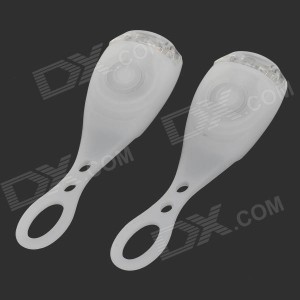 and bike lights can be found on many of them. Check out dx.com, dhgate.com, dollardays.com, and globalsources.com for a few examples, or do a search for bulk bike lights or wholesale bike lights. Look for lights that come with batteries included, so you don’t have to buy batteries separately and pack them by hand. Lights with simple attachment mechanisms are best – the “tadpole” light design with a wrap-around silicone loop seems to work really well, whereas designs using velcro straps or screw-together mounting brackets are much harder to install. Go for light sets of one white and one red light – some light suppliers sell red and blue light sets, but these are definitely not street legal in th
and bike lights can be found on many of them. Check out dx.com, dhgate.com, dollardays.com, and globalsources.com for a few examples, or do a search for bulk bike lights or wholesale bike lights. Look for lights that come with batteries included, so you don’t have to buy batteries separately and pack them by hand. Lights with simple attachment mechanisms are best – the “tadpole” light design with a wrap-around silicone loop seems to work really well, whereas designs using velcro straps or screw-together mounting brackets are much harder to install. Go for light sets of one white and one red light – some light suppliers sell red and blue light sets, but these are definitely not street legal in th
e US! Finally, avoid the really weak lights with low power LEDs – they may be cheap but they don’t provide enough illumination. We’re usually able to find lights for less than $4 per set, and will buy 50-100 lights at a time.
Get Some Volunteers
Talk to your friends, network at social rides, start a Facebook page, ping your mailing list – whatever it takes to get a handful of volunteers willing to hunt down bike ninjas and give them free stuff! The best way to entice people to help is by making the event fun – bribe them with free pizza after the ride, get a portable speaker and some music playing, hand out costumes. Sparkly lights and fairy wings are a good choice; ninjas have a known weakness to fairies.
Pick a Date, Time, and Location
Here in Tempe, there are a number of key streets and intersections that have high ridership, mostly around the ASU campus. We like to stake out Mill Avenue, University Drive, and Apache Boulevard is prime ninja-hunting streets. Where you set up depends on where you see bike ninjas most frequently. Is there a university nearby with student housing concentrated off-campus? Do some streets concentrate cyclists due to the presence of bike lanes, protected lanes, or other bike-friendly features? Think about what time of day has the highest traffic and what the light conditions are like. Once you’re actively looking for them, bike ninjas are easy to spot after dusk but hard to identify between sundown and proper night – is that rider a ninja, or do they have lights and are waiting to turn them on?
Hand Out some Lights! (but Be Nice About It)
When the big night arrives, get ready to chase people down and give them lights! Bring a backpack or panniers to carry your lights around. Watch for vehicular traffic while you’re out – you’re going to be making a lot of U-turns and stops, so be extra conspicuous with your signaling. When you catch up to a bike ninja, be nice to them! Tell them you saw them riding without lights and you’d like to give them a free set, no strings attached. If they accept, that’s great! Congratulate yourself on defeating a bike ninja. If they decline, that’s okay too. Don’t push the issue or harass them, just let them go on their way.
One issue in particular to keep in mind: think about what your reaction would be if you were biking along, at night, and a stranger suddenly appeared and offered you free stuff. You’d probably feel suspicious and possibly a little nervous. Maybe this weird bike person is trying to mug or assault you. This is a normal reaction for people to have, so try your best to be as non-threatening as possible. Stick to areas that are highly trafficked and well-lit, and don’t pursue people who aren’t interested.
You Saved Your Town From the Bike Ninjas! Now Go Party!
Eat that pizza you used to bribe your volunteers, have something nice to drink, and congratulate yourself on a job well done. Plan your next bike lights for ninjas ride, and get those volunteers signed up for it.


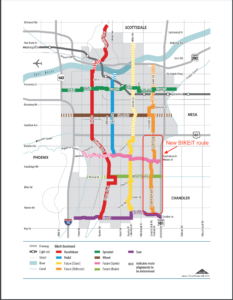
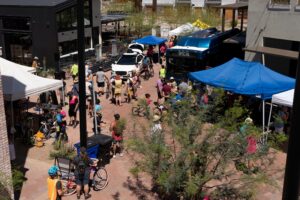
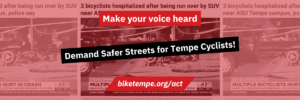
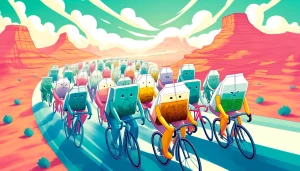

Excellent article and graphics! Wanted to let you know that I’ve re-posted your “Don’t be a Bike Ninja!” graphic on our bike safety page w/ a link back to this page. http://msubikes.wordpress.com/2014/04/04/bike-safety-tips/
One thought on the kinds of bikes to give away; I’d argue that getting lights that have standard size batteries (AAA or AA) would be much more likely to be replaced by the recipient and used for a longer time than the ones you mention here that use the computer-size batteries which are harder to find and sometimes quite expensive. They’ll be brighter too. Yes, they might be harder to install and more expensive per unit but in the long run I think they’ll save more lives.
Hi Tim, we’re glad you found it helpful! I pointed your comment out to Ben who wrote it.
I definitely agree. We have a lead on a $20 rechargeable light set, which would be ideal. Lights that use AAA/AA batteries cost more than these $4 lights, especially if they aren’t really junky. One of the major advantages to these cheap lights is that they’re easily installed (Nog style rubber/silicone bands) and removed, and light theft is a huge problem out here, which in itself is dumb. ASU Parking and Transit Services also has really cheap lights. There should be enough for everyone. But right now, it’s a problem that keeps people from even bothering trying to use lights. One thing we might explore is working with the bike shops to provide cheap button cell batteries and putting their info and this fact on stickers on the packages. If we can track down any inexpensive easily removable/installable AA/AAA powered lights, we’ll do that. Existing models have multiple plastic pieces and require a screwdriver, which is more than what students seem to have attention for. Once installed, they clip on/off, but I’m holding out for the Nog style stretchy band mounts. So, until then, we’re just hoping that these cheap lights get people hooked on lights and then they resolve to make the effort after that. It’s really a Fischer Price “my first bike light” type thing.
-scott